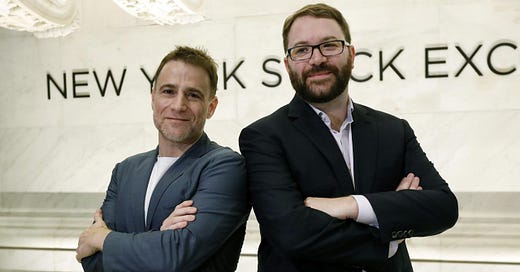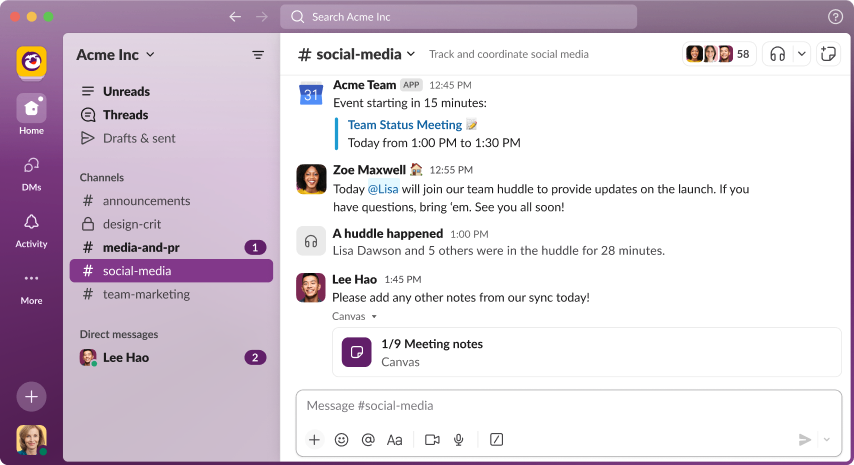Welcome friends ☕️
Today, we’re talking about Slack, a team communication platform that was acquired by Salesforce in 2021 for $27.7 billion. Let’s dive into how it all began and what we can learn from its success.
How a Failing Game Company Marketed Its Internal Tool
What is Slack and Who Started It?
Slack, the popular communication platform, was founded by Stewart Butterfield, Eric Costello, Cal Henderson, and Serguei Mourachov in 2013.
Stewart Butterfield, was the co-founder of a company called Ludicorp, which was working on a multiplayer online role-playing game. After the game failed to launch, they launched the photosharing website Flickr, which Yahoo acquired! A few years later, Butterfield co-founded a new company called Tiny Speck to develop a new online game called Glitch. Despite the game’s eventual failure, it laid the groundwork for what would become one of the world's most successful business communication tools. During the development of Glitch, the team created an internal tool for communication, which eventually became Slack.
Now Slack competes with similar chat tools like Microsoft Teams, Google Chats, Workplace, and Workplace. Despite some of its competitors who have been around for a while, nearly 80% of Fortune 100 companies use Slack. 1.5 billion messages are sent on the service every week.
How Did They Come Up with the Idea?
As Butterfield was trying to salvage the remains of Tiny Speck (the company that made Glitch), he saw potential in an internal communication tool he developed for the Tiny Speck team. They realized Slack, or “Searchable Log of All Communication and Knowledge”, created a productive way of working and they all agreed they wouldn’t work without a system like this again. They decided to pivot and focus on creating a product that would solve communication challenges for businesses.
From Idea to MVP: The Development Timeline
Transitioning from a game company to a communication tool provider took time. After deciding to pivot in late 2012, the team spent about six months developing the minimum viable product (MVP) for Slack. Their MVP included essential features such as real-time messaging, searchable message archives, file sharing, and integrations with third-party services like Google Drive and Dropbox. These features were designed to streamline communication and make it easier for teams to collaborate effectively.
Acquiring Customers
After creating their Alpha release, they focused on getting it out into the real world. They zeroed in on friends at startups who might be interested to use Slack before it was really ready or polished. The team had a history in many different startups so finding volunteers for the product was not hard.
When sharing to these startups, Stewart suggested they quit email for a week and do all of their internal communication in Slack. He knew the test wouldn’t work if some of the team stayed on email and conversations became fragmented. They wanted teams to go all-in on Slack and tell us what it was lacking. As they continued to share to new beta users, bugs came in and they quickly worked to address them.
By summer 2013, Slack’s MVP saw organic growth from the early testers at tech companies like Rdio and Medium. This growth provided critical feedback, helping improve the product. As usage increased, the team expanded to handle support and reliability. They refined the UI with help from design agency Metalab, launching a "Preview Release" in August 2013. The release aimed to attract at least 1,000 signups, but exceeded expectations with 15,000 signups in two weeks, indicating strong market interest.
First version of slack.com in early June of 2013
Key Takeaways for Success
Slack's journey offers several key takeaways for success:
Solving a Personal Problem: Slack originated from an internal tool developed for the Tiny Speck team, addressing their communication challenges.
Customer Feedback and Iteration: Early testers from tech startups provided crucial feedback, helping the team rapidly improve the product.
Targeted Early Users: Slack focused on getting initial users from their network of startup contacts, ensuring engaged and relevant feedback.
Strong Market Validation: The product saw significant organic growth and high demand during the Preview Release, confirming market interest.
📚 Good Reads
Startup Playbook first published a month before the founding of OpenAI in 2015
Building a following is one of the Best Investments [Twitter]
What is one entrepreneurship lesson you learned early? [Reddit]
How TikTok’s first engineer left to build an open-source product [Indie Hackers]
🛠️ Tools and Resources
Competitor Research - This lets you generate detailed reports about your competitors
MindPal - Enables you to build custom AI tools that automate anything








